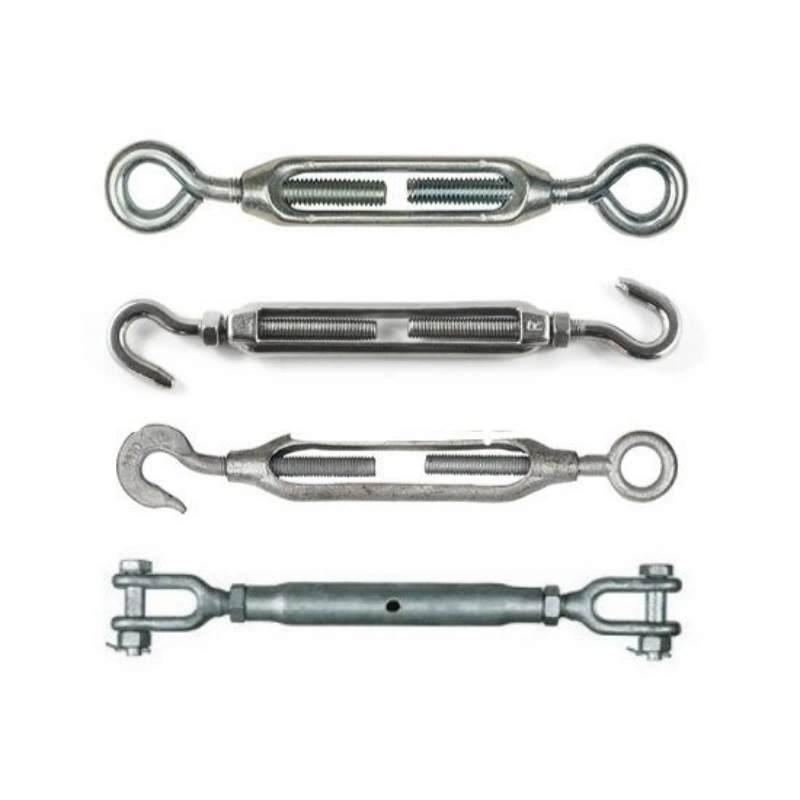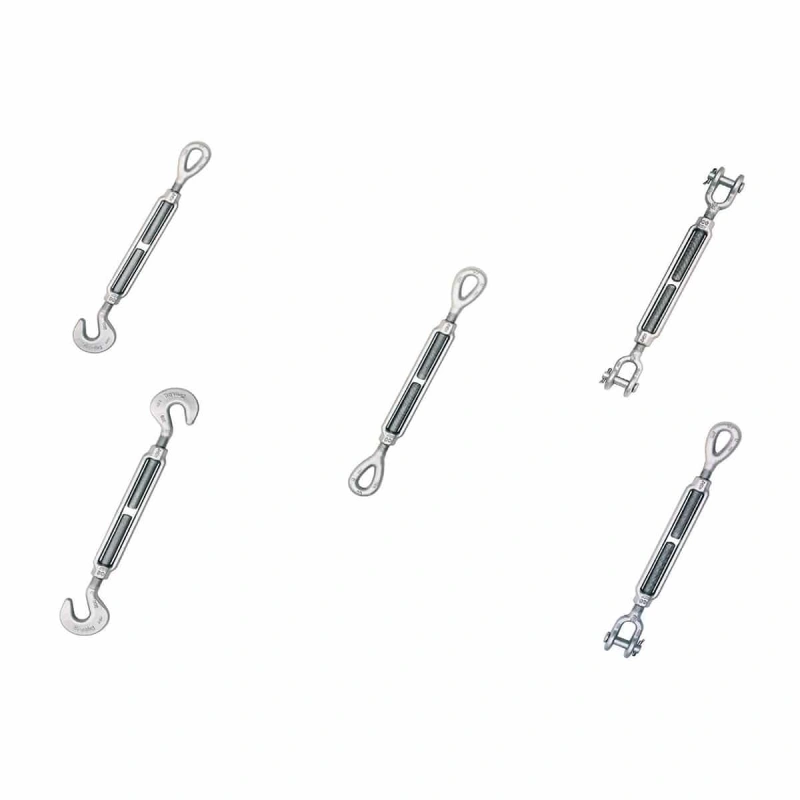You use turnbuckles to adjust the tension and length of cables, ropes, or rods with precision. In construction, these tools help you secure scaffolding and maintain tension on structural materials. Industries like marine, utilities, and manufacturing rely on turnbuckle solutions for both safety and efficiency.
As demand grows for lightweight, high-strength options, you see more choices that meet modern performance needs. Powerful Machinery delivers certified products trusted for reliability and durability across these vital sectors.
Key Takeaways
Turnbuckles are essential for adjusting tension in cables, ropes, and rods, ensuring safety and stability in construction and other industries.
Choose the right type of turnbuckle based on your application needs. Options include jaw, eye, and hook fittings, each serving specific purposes.
Select materials wisely. Stainless steel is best for marine environments, while galvanized steel is suitable for outdoor construction.
Regularly inspect and maintain turnbuckles to prevent wear and ensure safety. Check for corrosion and proper tension settings frequently.
Follow installation guidelines carefully. Proper setup and adjustments enhance performance and extend the lifespan of turnbuckle hardware.
Turnbuckles: Structure and Function
Basic Components
When you examine a turnbuckle, you notice three main parts that work together to create a reliable tensioning device. The central body connects two threaded ends, each fitted with a specific attachment.
These attachments, called end fittings, can be eyes, hooks, or jaws. Each end uses opposite threading—one right-hand and one left-hand—so you can adjust tension by rotating the body.
Here’s a quick overview of the key components and their roles:
Component | Description |
|---|---|
Body | The central part that connects the two threaded ends, often hexagonal or square for grip. |
End Fittings | Includes eyes, hooks, or threads to connect the turnbuckle to materials; one right-hand and one left-hand threaded. |
Threading | Coarse or fine threads for easy adjustment; pitch affects the tension applied with each turn. |
You benefit from this design because it allows for precise tensioning and secure connections in a wide range of applications.
Powerful Machinery manufactures turnbuckles using high-quality materials like stainless steel or drop-forged steel. This commitment to material quality ensures strength, durability, and corrosion resistance, even in harsh environments.
How Tension Is Adjusted?
You adjust a turnbuckle by rotating its central body. As you turn the body, the threaded ends move closer together or farther apart, depending on the direction. This action increases or decreases the tension in the connected cable, rope, or rod.
The threading design, whether coarse or fine, determines how much tension you can apply with each turn.
The design of the end fittings also plays a crucial role in performance. High-quality materials and precision engineering reduce wear and tear, giving you a longer service life and reliable results.
Safety features prevent accidental loosening under load, which is essential in demanding industries. Easy installation means you can set up and adjust turnbuckles without specialized tools, saving you time and effort.
Powerful Machinery’s certified products meet international standards, so you can trust their turnbuckles for critical projects in construction, marine, and industrial settings.
Types of Turnbuckles
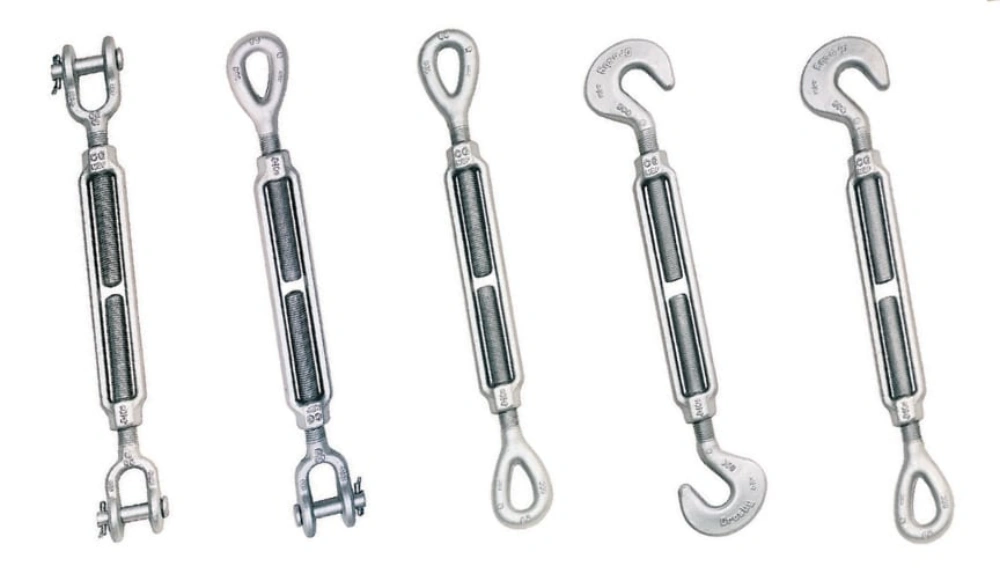
When you select turnbuckle hardware for your project, you need to understand the different types of turnbuckles available. Each type offers unique advantages for specific applications. Powerful Machinery provides a wide range of turnbuckles, ensuring you find the right fit for your needs.
End Fittings: Eye, Hook, Jaw
You encounter several types of end fittings when working with turnbuckle hardware. The most common options include eyes, hooks, and jaws. Each fitting serves a distinct purpose and offers specific benefits in various settings.
Type of Turnbuckle | Description | Advantages in Applications |
|---|---|---|
Jaws at both ends for secure connections. | Ideal for rigging applications like securing sails or tensioning wires. | |
Eye and Eye Turnbuckle | Loops at each end for easy attachment. | Suitable for straight-line pulls, such as supporting overhead cables. |
Hooks at both ends for convenient attachment. | Commonly used in temporary tensioning, like supporting banners. | |
Stub End | Threaded stud at one end and a loop, eye, or hook at the other. | Useful for applications needing one permanent attachment and adjustability. |
Threaded rod with a pivoting toggle mechanism. | Great for quick installation and adjustment in fencing or netting. |
You often use a jaw and jaw turnbuckle when you need a secure, non-slip connection. The jaw and eye turnbuckle combines a jaw on one end and an eye on the other, giving you flexibility for mixed attachment points.
The hook and eye turnbuckle allows for quick connection and removal, making it ideal for temporary setups. Powerful Machinery offers all these types, including specialized toggle and toggle turnbuckles for marine and rigging applications.
Tip: Choose the end fitting based on your connection needs. Eyes provide a permanent, secure link, while hooks allow for fast adjustments.
Body Styles: Open, Closed
The body style of your turnbuckle hardware affects both durability and maintenance. You can choose between open and closed body designs, each with its own strengths.
Feature | Closed Body Turnbuckles | Open Body Turnbuckles |
|---|---|---|
Durability | Enhanced due to protection from external elements | More exposed, leading to potential wear |
Maintenance Requirements | Generally requires less maintenance | Increased maintenance due to exposure |
Open body turnbuckles let you inspect threads easily and make frequent adjustments. You often see these in construction and rigging, where quick checks are important. Closed body turnbuckles protect internal threads from dirt and moisture, making them ideal for marine environments or outdoor use.
Powerful Machinery manufactures both styles, using high-quality stainless steel and drop-forged steel to ensure long-lasting performance.
Specialized Turnbuckles
Some projects require specialized turnbuckle hardware to meet unique demands. You find options designed for specific industries, each built to comply with strict standards.
Type | Description | Applications | Materials Used |
|---|---|---|---|
Open-Body Turnbuckles | Exposed body for easy inspection; suitable for frequent adjustments. | Construction, Rigging | Stainless Steel, Galvanized Steel |
Closed-Body Turnbuckles | Fully enclosed design; minimizes debris entry; ideal for harsh environments. | Marine Applications | High-Strength Aluminum, Specialized Alloys |
Swage Turnbuckles | Designed for high strength and aesthetics; seamless connection. | Architectural Projects | High-Grade Stainless Steel |
You might use a swage turnbuckle in architectural projects where appearance and strength matter. For marine or corrosive environments, closed-body turnbuckles made from high-strength alloys offer superior protection.
Powerful Machinery’s toggle and toggle turnbuckles, crafted from marine-grade stainless steel, deliver exceptional corrosion resistance and flexibility for demanding rigging jobs.
Material Options and Standards
When you choose turnbuckles, you must consider the material. Stainless steel turnbuckles provide excellent resistance to rust, chemicals, and saltwater. Galvanized turnbuckles offer good corrosion resistance for outdoor use and are economical for standard construction or fencing.
Powerful Machinery uses only premium materials, ensuring every turnbuckle meets or exceeds international standards.
Galvanized turnbuckle: Coated with zinc for outdoor durability.
Stainless steel turnbuckle: Withstands harsh, corrosive environments.
Turnbuckles often operate in high-tension, corrosive settings. High tensile strength stainless steel ensures your hardware performs reliably in industrial and marine applications.
Note: Powerful Machinery’s turnbuckle hardware complies with global standards such as JIS and ASME B30.26. These certifications guarantee quality, safety, and dimensional accuracy for every product.
You can trust Powerful Machinery to supply the right types of turnbuckles for your project, whether you need a jaw and eye turnbuckle for construction, a hook and eye turnbuckle for rigging, or a specialized toggle and toggle turnbuckle for marine use.
Each product delivers strength, reliability, and compliance with the highest industry standards.
Selecting Turnbuckles
Choosing the right turnbuckle hardware for your project ensures safety, reliability, and long-term performance. You need to consider several factors before making a selection, including material, load capacity, and the specific environment where you plan to use the hardware.
Material Choices
You should always match the material of your turnbuckle hardware to your application’s demands. Stainless steel works best in marine or high-humidity environments because it resists corrosion and maintains strength over time.
Galvanized steel offers a cost-effective solution for outdoor construction or fencing, providing good protection against rust. Aluminum turnbuckles are lightweight and suitable for less demanding applications.
Environmental factors like humidity and temperature can affect material fatigue and corrosion rates, so always assess your site conditions before choosing.
Stainless steel: Best for marine, industrial, or corrosive environments.
Galvanized steel: Suitable for outdoor use and general construction.
Aluminum: Lightweight, ideal for temporary or light-duty projects.
Tip: High humidity and temperature changes can accelerate corrosion and fatigue in metals. Select materials that withstand your environment.
Load Capacity and Standards
You must check the working load limit (WLL) for each type of turnbuckle hardware. The WLL varies by model, size, and material. Always select hardware that exceeds your project’s maximum expected load.
Manufacturers like Powerful Machinery provide detailed specifications and ensure compliance with international standards such as ISO9001 and TUV Rheinland.
Model Number | Description | Size (in) | WLL (lbs) |
|---|---|---|---|
C0404EE | Eye & Eye | 1/4 | 500 |
C0504EE | Eye & Eye | 5/16 | 800 |
C0606EE | Eye & Eye | 3/8 | 1,200 |
C0806EE | Eye & Eye | 1/2 | 2,200 |
C1006EE | Eye & Eye | 5/8 | 3,500 |
C2418HE | 1-1/2 | 7,500 | |
C2424HE | 1-1/2 | 7,500 |
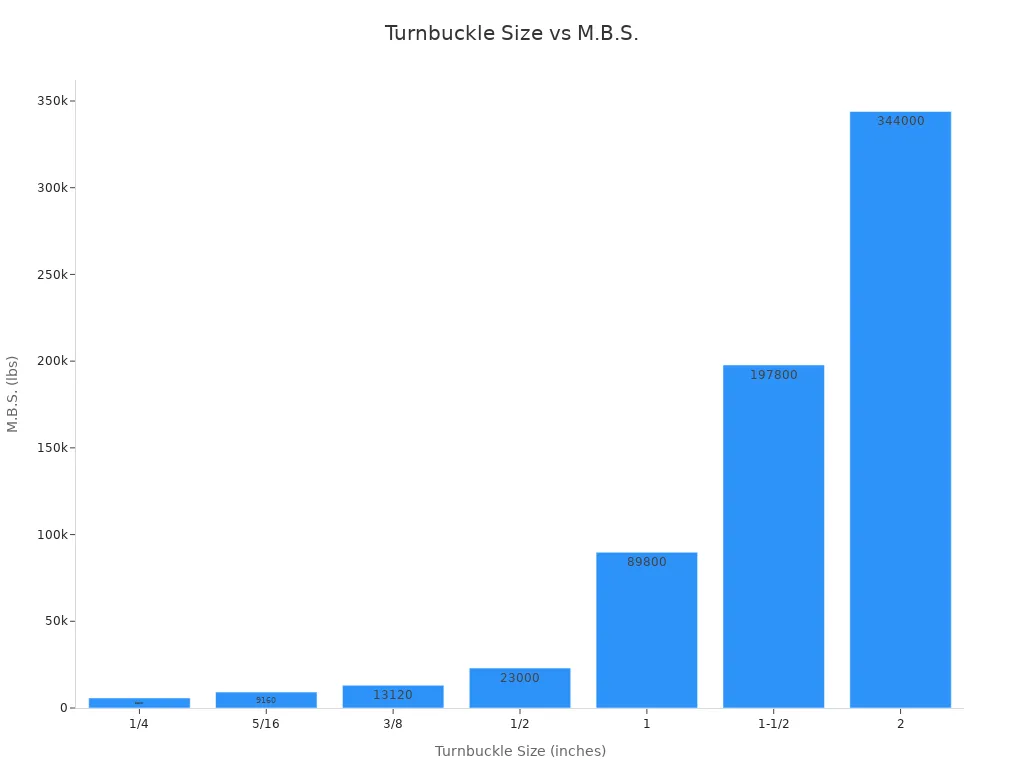
Note: Always look for turnbuckle hardware with certifications from recognized organizations. This ensures your hardware meets strict safety and quality benchmarks.
Application Fit
You need to match the type of turnbuckle hardware to your specific application. For example, eye and eye types work well for permanent, straight-line tensioning. Hook and hook types allow for quick connections and are ideal for temporary setups.
Toggle and toggle turnbuckles provide flexibility in marine rigging. Always review the design and ease of use for each type to ensure a secure and efficient installation.
Eye and eye: Permanent, secure connections.
Hook and hook: Fast, temporary attachments.
Toggle and toggle: Flexible, high-strength marine use.
Powerful Machinery offers a full range of certified turnbuckle hardware, with detailed product specifications to help you select the right solution for your needs.
Turnbuckles in Industry Applications
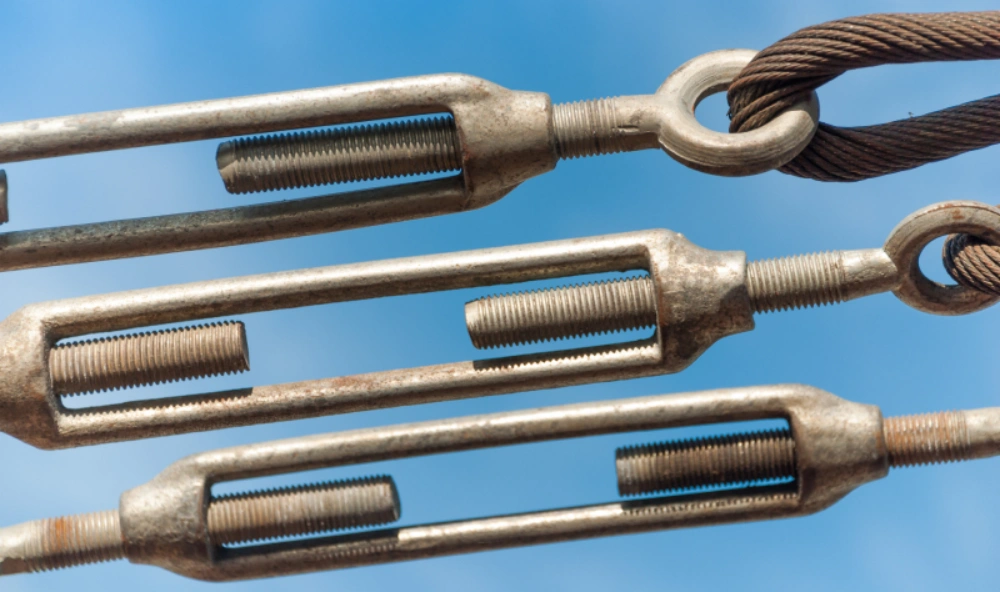
Construction
You rely on turnbuckle hardware in construction to secure scaffolding, tension support cables, and maintain the integrity of bridges and large structures. Turnbuckles allow you to make precise tension adjustments, which helps you keep materials stable and safe.
Regular maintenance of turnbuckle hardware prevents equipment failure and costly downtime. You benefit from corrosion-resistant options, especially when working outdoors or in humid environments. These types of turnbuckles enhance safety and efficiency on your job site.
Turnbuckles allow for precise tension adjustments.
They enhance the safety of construction operations.
Regular maintenance of turnbuckle hardware prevents equipment failure and costly downtimes.
Marine and Cargo
You use turnbuckle hardware in marine and cargo applications to secure loads, stabilize ship rigging, and manage tension in mooring lines. Stainless steel types resist corrosion from saltwater and harsh weather.
Powerful Machinery’s toggle and toggle turnbuckles provide flexibility and strength for demanding marine environments. You depend on these turnbuckle hardware solutions for both permanent installations and temporary connections during cargo handling.
Industrial and Rigging
You find turnbuckle hardware essential in industrial and rigging settings. These types help you adjust tension in wire ropes, support heavy machinery, and ensure the stability of suspended loads.
You choose turnbuckles with high-tensile strength for critical operations. Powerful Machinery’s product range includes hook and hook eye, hook eye, and specialized turnbuckle hardware for quick adjustments and secure connections.
Other Sectors
Turnbuckle hardware supports a variety of industries beyond construction and marine. You use these types in entertainment for stage rigging, in agriculture for fencing, and in renewable energy for tensioning solar panel supports. Each sector has specific requirements for durability, safety, and ease of installation.
Industry Sector | Specific Requirements |
|---|---|
Reliance on turnbuckles for securing scaffolding, bridges, and structural supports; need for corrosion-resistant options. | |
Marine and Offshore Applications | Demand for corrosion-resistant materials; used for securing cargo and stabilizing structures in harsh environments. |
Entertainment and Event Rigging | Requirement for precise tensioning in stage setups and lighting rigs; focus on safety and quick adjustments. |
Agricultural and Landscaping | Use for tensioning fencing and support structures; preference for durable, weather-resistant options. |
Renewable Energy Installations | Critical for maintaining tension in wind turbines and solar panel supports; innovations in materials for easier installation. |
Tip: You should select turnbuckle hardware based on your industry’s specific needs. Powerful Machinery’s global customer base trusts these products for their versatility and certified quality.
Installation and Safety
Installation Steps
You achieve reliable performance by following a systematic approach when installing turnbuckle hardware. Begin by gathering all necessary tools, such as wrenches, pliers, and safety gear. Identify the optimal location for your turnbuckle, ensuring easy access for future adjustments.
Thread the turnbuckle onto the cable or rod ends, confirming correct orientation and secure threading. Use wrenches to tighten both ends, but avoid over-tightening to prevent damage.
Adjust the tension by turning the center body, checking alignment and stability of the connected components. After installation, inspect the turnbuckle hardware regularly for signs of wear or loosening.
Common mistakes to avoid:
Neglecting to inspect the entire rigging system
Using incompatible components
Improperly securing clevis pins
Overlooking tension adjustment
Forgetting to replace toggles
Skipping regular maintenance checks
Tip: Always follow manufacturer guidelines and use only compatible types of turnbuckle hardware for your application.
Inspection and Maintenance
You maintain safety and extend the lifespan of turnbuckle hardware by performing routine inspections. Check for signs of wear, corrosion, and proper tension settings. Professional inspections help you detect misalignment or damage early. Schedule regular maintenance to ensure all components remain secure and functional.
Inspection Task | Frequency | Action Required |
|---|---|---|
Visual check for wear | Monthly | Inspect for cracks, corrosion |
Tension verification | Before use | Confirm proper tension |
Component alignment | Quarterly | Adjust as needed |
Safety Tips
You protect yourself and your equipment by following strict safety protocols during the installation and use of turnbuckle hardware. Always check for wear, corrosion, or physical damage before each use. Verify that threads engage securely at both ends and maintain proper alignment to avoid side loading.
Apply loads gradually to prevent shock or jerky movements. Use locking devices in dynamic environments and select materials suitable for your operating conditions. Schedule regular inspections and keep detailed records of all procedures. Ensure personnel receive proper training and certification.
Powerful Machinery’s turnbuckle hardware meets international safety standards, including ISO9001 and TUV Rheinland, giving you confidence in every installation.
Conclusion
You improve project safety and efficiency when you select the right turnbuckles for each application. Certified, high-quality products from Powerful Machinery deliver long-term reliability and prevent costly failures.
Expert consultation helps you match hardware to your needs, considering load, environment, and use. Following safety standards ensures consistent performance and customer satisfaction.
Performance Factor | Benefit |
|---|---|
High-grade materials | Enhanced durability and strength |
Rigorous quality control | Reliable, defect-free products |
Expert engineering | Stable results in demanding environments |
Material improvements and design innovations continue to shape the future of turnbuckle technology.
FAQ
What materials do turnbuckles come in?
You find turnbuckles made from stainless steel, galvanized steel, and drop-forged steel. Stainless steel resists corrosion best. Galvanized steel works well outdoors. Drop-forged steel offers high strength for heavy-duty jobs.
How do you adjust a turnbuckle safely?
You rotate the central body to increase or decrease tension. Always check that threads engage fully. Avoid over-tightening. Use a wrench for better control. Inspect connections before applying load.
Which turnbuckle type fits marine applications?
You should choose stainless steel closed-body or toggle and toggle turnbuckles. These resist saltwater corrosion and provide reliable tensioning for rigging, mooring, and cargo handling.
How often should you inspect turnbuckles?
You inspect turnbuckles monthly for wear, corrosion, and alignment. Check tension before each use. Schedule quarterly professional inspections for critical systems.
Do Powerful Machinery turnbuckles meet safety standards?
You benefit from Powerful Machinery’s turnbuckles because they meet international standards like ISO9001 and TUV Rheinland. Certified products ensure safety and reliability in demanding environments.

